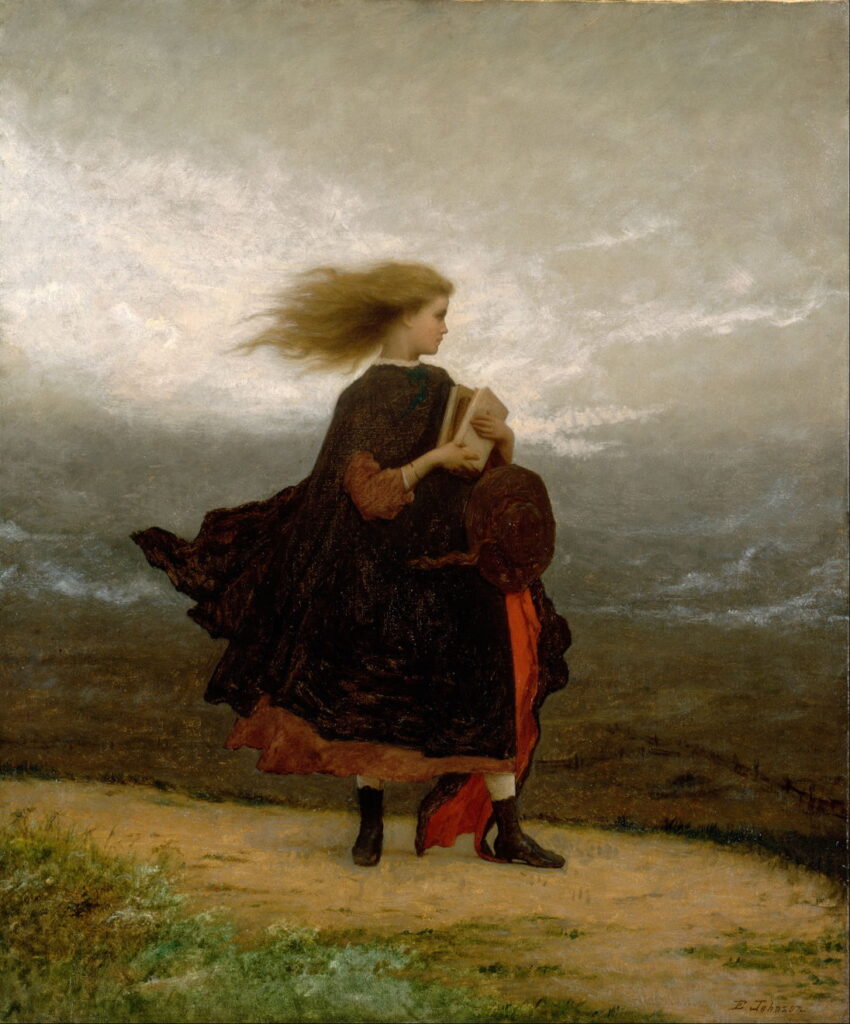Painting the blustery wind 1

Now that we are well into the autumn/fall in the northern hemisphere, it’s time for the wind to pick up after its summer calm. This weekend I’m hoping to stop short of a full gale, and enjoy walking in more of a blustery breeze, typical of the chalk ridges and coastal paths near here. This is a challenge for the visual artist: how to convince the viewer that invisible air is in brisk motion.
Evelyn De Morgan (1855–1919), Boreas and Oreithyia (c 1896), oil on canvas, dimensions not known, De Morgan Centre, London. Wikimedia Commons.
One classical solution that has been popular from the Renaissance is to show the wind billowing strips of fabric. Evelyn De Morgan’s Boreas and Orithyia (c 1896) is a late example reaching almost calligraphic extremes as they signify Boreas, the north wind, as he bears Orithyia aloft.
Katsushika Hokusai (葛飾北斎) (1760–1849),『駿州江尻』(Sunshū Ejiri), Ejiri in Suruga Province (Travellers Caught in a Sudden breeze at Ejiri, A Sudden Gust of Wind) (c 1830), woodblock color print, part of the series Thirty-six Views of Mount Fuji, no. 35. Dimensions and location not known. Wikimedia Commons.
One of the simplest and most effective images of people in the wind is Hokusai’s (葛飾北斎) brilliant woodblock print from about 1830 of『駿州江尻』(Sunshū Ejiri), Ejiri in Suruga Province, also known as Travellers Caught in a Sudden breeze at Ejiri or A Sudden Gust of Wind. On their own, the trees and grass couldn’t have the same visual impact as blown hats, clothing, and most of all the papertrail reaching high into the sky.
Peder Balke (1804–1887), The Harbor at Skjervøy (c 1844-46), oil on paper on cardboard, 12 x 17.5 cm, Private collection. The Athenaeum.
Peder Balke takes advantage of the richer clues provided in The Harbor at Skjervøy (c 1844-46). In this small fishing port in Troms, in the far north of Norway, the wind fills the sky with wheeling seabirds, heels the yachts, turns the sea white from breaking waves, and drives distant smoke almost horizontally.
Clarkson Frederick Stanfield (1793–1867), Oude Scheld – Texel Island, Looking towards Nieuwe Diep and the Zuider Zee (1844), oil and bitumen on canvas, 100.3 x 125.7 cm, The Tate Gallery (Presented by Robert Vernon 1847), London. © The Tate Gallery and Photographic Rights © Tate (2016), CC-BY-NC-ND 3.0 (Unported), http://www.tate.org.uk/art/artworks/stanfield-oude-scheld-texel-island-looking-towards-nieuwe-diep-and-the-zuider-zee-n00404
Clarkson Frederick Stanfield made his reputation from marine paintings showing the effects of wind and waves. In the summer of 1843, he toured the Netherlands, finding fresh motifs for his oil paintings, including Oude Scheld – Texel Island, Looking towards Nieuwe Diep and the Zuider Zee, completed in his studio the following year. Its fragmented clouds are paralleled by the frequent small waves, together building the effect of a brisk offshore breeze. The critics loved it.
Clarkson Frederick Stanfield (1793–1867), The Seashore at Dover (c 1849), oil on canvas, 42.6 x 62.9 cm, The Victoria and Albert Museum (Bequeathed by Miss E. Anderson), London. Image courtesy of and © Victoria and Albert Museum, London.
Clarkson Stanfield painted two versions of The Seashore at Dover in about 1849. It’s a windy day, with scattered and blustery showers. The famous white cliffs of Dover rise high in the distance, as the wind blows the tops off the small waves in the foreground. The construction work in the foreground relates to the final section of the London to Dover railway, which made travel from England to France much quicker and more convenient.
Ford Madox Brown (1821–1893), The Last of England (1852/55), oil on panel, 82.5 x 75 cm, Birmingham Museum and Art Gallery, Birmingham, England. Wikimedia Commons.
Ford Madox Brown painted his original oil version of The Last of England just along the Channel coast from Dover. The middle-class couple in the foreground are clearly not enjoying the fact that the ship they’re migrating on is ‘all one class’. They both stare with grim determination at the prospect of sharing the next few weeks with the rowdy working class passengers behind them, eating the same increasingly stale vegetables that are now slung from cords around the ship’s rail in front of them.
This isn’t just a couple, though: look closely at their hands, and the woman’s left hand is clutching the tiny hand of her baby, who is safely swaddled inside her weatherproof hooded travelling cape. Her right hand, wearing a black leather glove, grasps that of her husband, whose left hand is tucked under his heavy coat. Splashes of brilliant colour are supplied by the wind blowing the woman’s ribbons.
Other small details lend authenticity and a little humour: behind are the white chalk cliffs of Dover, consistent with this ship having sailed from London, and there’s a paddle steamer working its way inshore, closer to the cliffs. A cabin boy is selecting some vegetables for cooking from the lifeboat in the background, and a smaller ship’s boat reveals the name of the migrants’ vessel to be Eldorado, the mythical city of gold in Colombia.
Gustave Courbet (1819–1877), Autumn Sea (1867), oil on canvas, 54 x 73 cm, Ohara Museum of Art 大原美術館, Kurashiki, Japan. Wikimedia Commons.
Late in his career, Gustave Courbet’s coastal paintings came to concentrate on waves breaking on the beach, as in his Autumn Sea from 1867, where two sailing boats are the only forms to punctuate its horizon. They are heeling in the wind, which is also starting to blow the tops off the waves, as those dirty clouds scud rapidly across the sky.
Eastman Johnson (1824–1906), The Girl I Left Behind Me (1870-75), oil on canvas, 106.7 x 88.6 cm, Smithsonian American Art Museum, Washington, DC. Wikimedia Commons.
Eastman Johnson’s The Girl I Left Behind Me (1870-75) uses the popular devices of hair and clothing to place its single figure in a strong breeze, and show how this works best if they also look into the wind.
Jean-François Millet (1814-1875), The Gust of Wind (1871-73), oil on canvas, 90.5 x 117.5 cm, National Museum of Wales / Amgueddfa Cymru, Cardiff, Wales. Wikimedia Commons.
Although it depicts far more extreme conditions, Jean-François Millet’s Gust of Wind from 1871-73 must be the canonical painting of a storm. Its lone and distant figure is being blown almost double, as he’s nearly struck by a large branch torn from the tree to the left. Indeed, that tree is being uprooted, and its leaves pepper the storm sky at dawn.
I hope for more moderate conditions tomorrow, when I’ll show paintings from the last decades of the nineteenth century.



